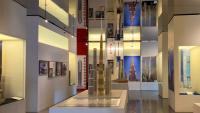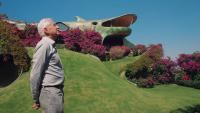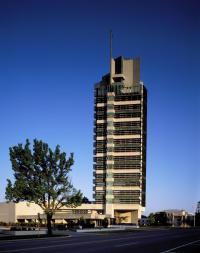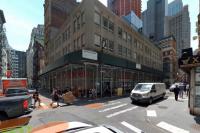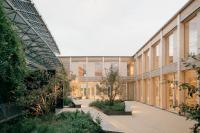Au Pont Rouge, Saint Petersburg, Russia
Saint Petersburg, Russia
Cheungvogl has created an open and transformable retail, exhibition and event space around a robotic system within the restoration of the 110-year-old iconic department store and UNSESCO World Heritage, Au Pont Rouge in Saint Petersburg, Russia.
Completed in 1907, Au Pont Rouge located along the Red Bridge on River Moika was built in the tradition of the great European department stores. Following the revolution in 1919, the building was renamed and converted into Volodarsky Sewing Factory and in the 1930s, the original cupola was demolished. Original non-structural elements were mostly destroyed or removed over the last century of factory use and abandonment. In 2011, the cupola was reconstructed.
The external envelope of Au Pont Rouge is restored to its original state in accordance with local regulations and UNSESCO World Heritage requirements. On the inside, the heavily damaged structural parts, the distinctive art-nouveau staircase, balustrades and windows are restored and repaired to its historical conditions.
Historically, department stores not only introduced the early modern retail model, but also had a strong influence on the social and urban network of cities and societies, acting as a catalyst for social exchange and redefining the role of consumerism. The origins of the department store lie in the accelerated economy expansion and growing affluent middle-class with the Second Industrial Revolution in the late 19th century. At the turn of the 20th century, transformations brought by the digital revolution, the so-called Third Industrial Revolution, and changes in consumption behaviour and social habits challenge the existence of High Street, department stores and the conventional retail model in general. Devoid of meaning, inner cities and communal identity are left with far greater challenges beyond economic means and consumerism. In this broad context, the emphasis on qualities and potentials of physical space and its social values defines key topics of concern and calls for experimentation in a project as such.
If the Second Industrial Revolution created the Department Store and the Third rendered it obsolete, we consider technological changes and cultural implications of the Fourth able to inform the concept to regain relevance under the preconditions of a new era as the term Revolution implies. It is the relevance of content that defines the relevance of a platform and if and how people will accept and use it. Therefore, it is not the physical space that lost its meaning, but the social and spatial interpretation of it. Comparing the current condition with the historical model, it becomes evident that social aspects have been completely replaced in favour of profit maximization of available areas. Paradoxically, it is the social component, which sets the quality of the physical store apart from highly efficient online commerce. With the social aspect being removed, the concept loses its relevance in a physical world. The institution itself as well as its physical representation eventually becomes irrelevant. As social habits generally do not shift as fast and as fundamental as cultural expressions of its time, we are in search of a new cultural interpretation and technical application of public and social space.
The interlink of information technologies with automated processes, commonly described as the Fourth Industrial Revolution, creates an intersection of analogue and digital processes. The change of operation helps to define the meaning of space, in which logistics and functions are removed or minimised to make room for new adaptations. In Au Pont Rouge, the space is designed to be largely freed from all trading operations and stocks with the implementation of a robotic system, opening potentials of alternative interpretations and usage other than the conventional department store layout and program. The focus is shifted towards spatial qualities of the architecture itself and how people can occupy it in new ways. The automated robotic system silently conducts all operational and logistical aspects in the background, connecting offline and online retail.
While analysing and overlaying the existing building with a new program, we experiment the notion of de-sequencing, firstly by its inherit scientific meaning to identify historic program, functions and structures. Secondly, in a literal adaptation of the term’s meaning, we avoid and remove any sequenced hierarchies within the new layout to create spaces free of prescribed functional definition, to leave room for freedom of interpretation and re-programming, which represents our understanding of contemporary social relevance in contrast to the static spatial order of the early 20th century. The new insertions are not passively adjusted to the given structure technically and conceptually. Both elements, old and new, are clearly identifiable and conceived to be coexisting side by side.
The translucent sheets describe a new layer in-between the historic façades, structural elements and atrium, with the atrium rooflight to be opened in the second phase of the project. The insertion is meant to appear more like a suggestion than a definition. The light layers project and amplify the change of natural light and hues over the course of day and seasons deep inside the space to connect the historic structure and the city in an immaterial way. Notably, the historic structure itself is not as geometrical perfectly aligned as the clear division of the façade implies and at its intersection, the old and new elements form a hybrid of attempt and approach 100 years apart.
Since its opening, the spaces have undergone various adjustments in terms of usage and occupancy, with some curatorial adaptations also due to the difficult economic situation since its inception. In addition, exhibitions, screenings, parties, banquets, fashion shows and other events have transitorily transformed the setting to suit various interpretations. The de-sequencing enables the architecture to become a platform, which can be re-programmed with varying content, as to our initial aim not to dictate content, but to enable content.
- Art + Installation + Exhibition
- Retail + Stores
- Spa + Wellness
- Shopping Centers + Malls
- Furniture / Product
- Architects
- Cheungvogl
- Location
- Moyka Embankment 73, Saint Petersburg, Russia
- Year
- 2016
- Client
- BTK Development
































